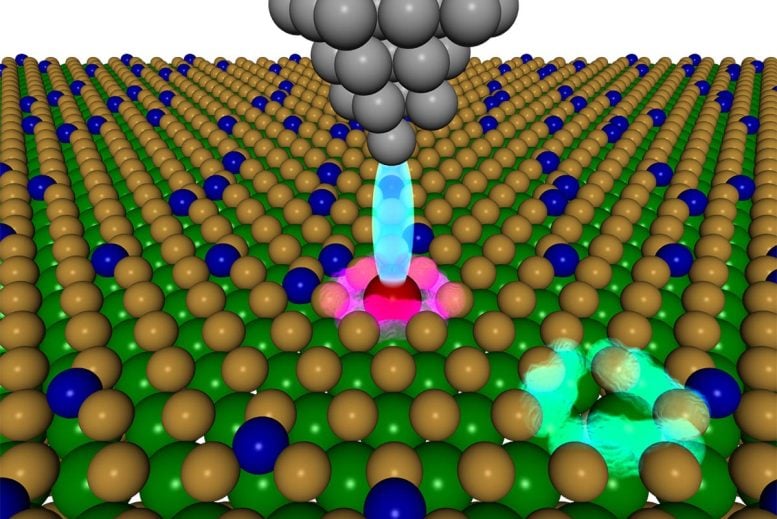Researchers have introduced a novel method that integrates computational analysis with precision fabrication to accelerate the identification of quantum defects, enhancing potential applications in computing and telecommunications. Their work has led to significant advancements and the establishment of a publicly accessible quantum defect database. Credit: SciTechDaily.com
A powerful combination of high-throughput computation and precise fabrication techniques has been developed to accelerate the discovery of quantum defects.
- For the first time, researchers have demonstrated an approach that combines high-throughput computation and atomic-scale fabrication to engineer high-performance quantum defects.
- The methods provide a novel pathway to accelerate the discovery of quantum materials for game-changing applications in computing, telecommunications, and sensors.
- The study team identified and precisely fabricated a promising quantum defect that replaces a sulfur
This image shows the cobalt defect fabricated by the study team. The green and yellow circles are tungsten and sulfur atoms that make up a 2D tungsten disulfide sample. The dark blue circles on the surface are cobalt atoms. The lower-right area highlighted in blue-green is a hole previously occupied by a sulfur atom. The area highlighted in reddish-purple is a defect – a sulfur vacancy filled with a cobalt atom. The scanning tunneling microscope (gray) is using electric current (light blue) to measure the defect’s atomic-scale properties. Credit: John C. Thomas/Berkeley Lab
The Promise of Quantum Defects
Quantum information science involves the use of atomic-scale phenomena to encode, process, and transmit information. One way to achieve this control is to create defects in materials – such as replacing one type of atom with another. These defects can be incorporated into systems that enable quantum applications.
“For defects to work for quantum applications, they need to have very specific electronic properties and structures,” said Geoffroy Hautier, a Dartmouth materials scientist and the project’s lead investigator. “They should preferably be able to absorb and emit light with wavelengths in the visible or telecommunications range.”
Two-dimensional (2D) materials – which are just one atom or molecule thick – are prime candidates to host such high-performance quantum defects due to their unique electronic properties and tunability.
Challenges and Innovative Solutions
There’s a catch, however. Defects with good quantum properties are very difficult to find.
“Consider the material tungsten disulfide (WS2),” said Sinéad Griffin, a Berkeley Lab scientist and one of the study’s principal investigators. “If you account for the dozens of periodic table elements that could be inserted into this material and all the possible atomic locations for the insertion, there are hundreds of possible defects that could be made. Looking beyond WS2, if you consider thousands of possible materials for defects, there are literally infinite possibilities.”
Functional quantum defects are typically discovered by accident. The traditional approach is for experimentalists to fabricate and evaluate defects one at a time. If one defect doesn’t have good properties, they repeat the process for another one. When a good one is finally found, theorists investigate why its properties are good. Exploring the hundreds of possible defects for WS2 in this manner would take several decades.
“Consider the material tungsten disulfide. If you account for the dozens of periodic table elements that could be inserted into this material and all the possible atomic locations for the insertion, there are hundreds of possible defects that could be made. Looking beyond WS2, if you consider thousands of possible materials for defects, there are literally infinite possibilities.”
– Sinéad Griffin
Harnessing Computational Power
The study team flipped this traditional approach, starting with theory and finishing with experiments. The basic idea: use theoretical computation as a guide to identify a much smaller number of promising defects for experimentalists to fabricate.
Hautier, Griffin, and postdoctoral researchers Yihuang Xiong (Dartmouth) and Wei Chen (UCLouvain) developed state-of-the-art, high-throughput computational methods to screen and accurately predict the properties of more than 750 defects in 2D WS2. The defects involved substituting a tungsten or sulfur atom with one of 57 other elements. The calculations were designed to identify defects with an optimal set of properties related to stability, electronic structure, and light absorption and emission.
The massive number of calculations, based on quantum mechanics principles, took advantage of the high performance computing resources at the National Energy Research Scientific Computing Center (NERSC) at Berkeley Lab. The analysis identified one defect – made by substituting a sulfur atom with a cobalt atom – with particularly good quantum properties. Before the study, no defect in WS2 was known to have these properties.
In addition to the traditional publication format, the team is sharing the results of its search with the global research community in a publicly available database called the Quantum Defect Genome. The researchers started the database with WS2 and have extended it to other host materials such as silicon. The aim is to encourage other researchers to contribute their data and build a large database of defects and their properties for various host materials.
Playing With Atoms Like LEGO Bricks
The next step was for experimentalists to fabricate and examine this cobalt defect. Such a task has historically been challenged by a lack of control over where defects form in materials. But Berkeley Lab researchers found a solution. Working at the Molecular Foundry, the team developed and applied a technique that enables atomic-level precision in fabrication.
Here’s how it worked: A 2D WS2 sample in a super-low-temperature vacuum was heated, and its surface was blasted with argon ions at just the right angle and energy. This caused a small fraction of the sulfur atoms to pop out, leaving tiny holes in the material. A mist of cobalt atoms was applied on the surface. The sharp metal tip of a scanning tunneling microscope was used to find a hole and nudge a cobalt atom into it – similar to putting in golf. Finally, the researchers used the microscope’s tip to measure the electronic properties of the cobalt defect.
“The microscope’s tip can see individual atoms and push them around,” said John Thomas, a Berkeley Lab postdoctoral researcher who conducted the fabrication. “It allows us to select a specific location for the cobalt atom and match the structure of the defect identified in the computational analysis. We’re essentially playing with atoms like LEGO bricks.”
Importantly, this method enables fabrication of identical defects. This is necessary for defects to interact with each other in quantum applications – a phenomenon known as entanglement. In quantum communications, for instance, one possible application is for defects to transmit information across a long-distance fiber-optic cable through light emission and absorption.
Experimental Confirmation of Theoretical Predictions
The experimental measurements of the defect’s electronic structure agreed with the computational predictions, demonstrating the DOI: 10.1038/s41467-024-47876-3
The Molecular Foundry and NERSC are DOE Office of Science user facilities at Berkeley Lab.
The research was supported in part by DOE’s Office of Science.



